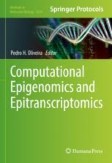Search
Search Results
-
Repeat DNA Sequences in Flax Genomes
Transposable elements (TE) are important components in plant genomes. They are abundant, not only in flax but also in a wide range of species,...
-
Analysis of genetic variability among bivoltine and multivoltine silkworm genotypes using inter simple sequence repeat and simple sequence repeat markers
The silkworm is an ideal lepidopteran model for the study of genetics and genetic diversity. In this study, inter-simple sequence repeats (ISSR) and...

-
Repeat DNA methylation is modulated by adherens junction signaling
Through its involvement in gene transcription and heterochromatin formation, DNA methylation regulates how cells interact with their environment....

-
Genetic diversity analysis of Palestinian safflower (Carthamus tinctorius L.) using inter simple sequence repeat (ISSR) markers
The genetic characterization of Palestinian safflower landraces remains unknown due to the absence of prior research using molecular methods....

-
Repetitive DNA sequence detection and its role in the human genome
Repetitive DNA sequences playing critical roles in driving evolution, inducing variation, and regulating gene expression. In this review, we...

-
DNA Sequence Assembly and Annotation of Genes
This chapter describes the different sequencing strategies, the pros and cons of the different strategies to help you select the optimal DNA...
-
Inter simple sequence repeat (ISSR) markers reveal DNA stability in pineapple plantlets after shoot tip cryopreservation
Although pineapple ( Ananas comosus var. comosus ) shoot tips have been cryopreserved but the possible effect of this process at the molecular level...

-
Predicting Chromatin Interactions from DNA Sequence Using DeepC
The genome 3D structure is central to understanding how disease-associated genetic variants in the noncoding genome regulate their target genes....
-
Genetic diversity of Dendrobium species revealed by simple sequence repeat (SSR) markers
Dendrobium is an epiphytic orchid, which is highly valued as a cut flowers. The assessment of genetic diversity is crucial to study the relationship...

-
Identification of the Sequence and the Length of Telomere DNA
Telomeres are essential nucleoprotein structures at the very ends of linear eukaryote chromosomes. They shelter the terminal genome territories...
-
Assessing the genetic diversity of Buchanania lanzan Spreng. (Chironji) using inter simple sequence repeat markers
Buchanania lanzan Spreng, a member of the Anacardiaceae family, is a valuable tropical fruit tree native to India. This tree species possesses...

-
Genetic diversity analysis of pea (Pisum sativum l.) landraces by utilizing simple sequence repeat markers
The objective of current study was to differentiate among 46 pea genotypes collected from different areas of Azad Jammu and Kashmir and NARC...

-
Inter simple sequence repeat markers to assess genetic variability of Mauritanian sorghum (Sorghum bicolor L.)
Studying the genetic variability of local Mauritanian sorghum accessions holds significant importance within the context of sorghum improvement and...

-
Hybridization and introgression of two sympatric Lycium species revealed by simple sequence repeat (SSR) markers
Hybridization and introgression are important ways to promote genetic variation and play important roles in the evolution of species. Two sympatric Lycium...

-
Revealing genetic diversity of tulips in Turkey with inter-simple sequence repeat markers
In order to reveal the genetic variation within the genus Tulipa, 57 accessions belonging to 19 taxa that are native to Turkey were examined in our...

-
Assessing genetic diversity of indigenous bread and durum wheat cultivars in Iran using inter simple sequence repeat (ISSR) markers
Wheat, as a widely cultivated cereal crop, has encountered challenges due to its limited genetic diversity throughout its evolution. To facilitate...

-
Genetic diversity analysis of Ethiopian ginger (Zingiber officinale Roscoe) accessions using simple sequence repeat (SSR) markers
Understanding the existing genetic variation in the production system’s germplasm pool is the first step in any program aimed at improving crop...

-
Genetic diversity of wild Camellia oleifera in northern China revealed by simple sequence repeat markers
Camellia oleifera Abel., as one of the four major woody oilseeds, has a high economic value, and the wild C. oleifera genes, whose distribution area...

-
Development of mitochondrial simple sequence repeat markers to simultaneously distinguish cytoplasmic male sterile sources in cotton
Deleterious effects on anther development and main economy traits caused by sterile genes or cytoplasms are one of the important genetic...

-
Genome skimming and development of simple sequence repeat marker for the characterization of high-value drought endurant legume moth bean (Vigna aconitifolia J.)
This research presents a comprehensive analysis of the Gujarat Moth Bean 2 (GMO-2) genome, employing next-generation sequencing technology and...

